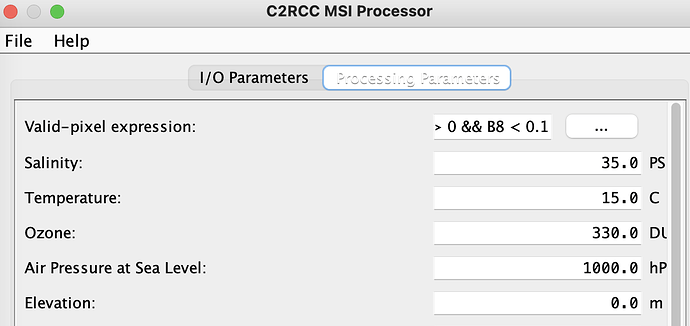I just checked, once again you are correct, thank you
Dear Peters
I am using C2RCC and it is working well. However, something came up while conducting my experiments. So far I have been using fixed values for (press, Temperature, ozone). I am thinking that this might cause a problem. I was wondering if you could help me with 3 questions I have:
- Does Press represent sea level pressure or surface pressure? These can be very different if my lake is at an elevation of 500 meters.
- Does Temp represent surface temperature or sea level temperature?
- What about ozone, are these ppm units?
I downloaded ERA5 reanalysis data and it seems that the data I can get from there are not the same as the ones C2RCC requires. For example it gives ozone in kg/kg in 6 levels (Ozone mass mixing ratio) within the atmospheric column. This is not the same as to say I have 330 pps that I need to put in C2RCC. So my question is where can I find the necessary meteo data? What would you recomend?
Thank you
Hi there,
- Press is the air pressure, if your lake is in high altitude, try to adapt the pressure value
- Temp is sea surface temperature
- Ozone is in Dobson units
I copy below some links to learn more about C2RCC:
Hi
I got a little confused, so let me try to clarify this:
- Press is surface pressure (needs adjustment for a lake at 300 m altitude if I only have sea level pressure).
- Temp is sea surface temperature (and NOT surface Temperature). .Which means that I need to adjust if I am over land at an altitude and I only have surface temperature.
- Ozone is the one that troubles me the most. I don’t think it is ppm. I think it is Dobson units (which measures the total ozone of the whole atmospheric column). The paper you suggested confirms this. One thing to note however, is that the paper addresses OLCI images and not MSI like in my case, but I assume this is the same.
Please correct me if I am wrong.
Thank you
Yes, sorry about the ozone, I corrected it.
The approach is the same for OLCI and MSI, the only remarkable thing is that you have two different nets for MSI, the normal and the extreme net. Depending on your water type you can choose one or another,
Hi again
Sorry for asking again, but I need one more clarification. In my xml file I have I have
C2RCC-Nets
and I think I have 2 more options (total of three NOT two). These are C2X-Nets and C2X-COMPLEX-Nets. Can you confirm that for case 2 waters (lakes) the only recommended option is the third option (C2X-COMPLEX-Nets)?
Thank you
Yep, I forgot the third option:
Hi
I think I made a correction to my previous post while you were typing your response. So Can you clarify which option is the most suitable for case 2 waters (inland lakes)?
Thank you
The best thing you could do it is to test the C2X and the C2X-Complex and see which one works better for you specific water type. The second one is more focused on high sediment concentration waters, that is, high turbidity cause by NAP. In some lakes, if there is a high variability of OWTs, you would probably need different nets for the different moments or water types.
Dear Dr Ruescas
Thank you for your help. I will try both nets. I am am concerned however about the meteo data. If I try to run C2RCC through SNAP in the Processing Parameters field it says that we have to insert the Sea Level Pressure. So I am a little confused on whether we have to insert the Sea Level Pressure or Surface Pressure (the latter is what you mentioned above). So, before I proceed with lots of computationally expensive experiments do you mind checking one more time which is the correct one?
Thank you
No worries. Ok, I checked on the GUI. We have “Air Pressure at Sea Level” (hP) and the elevation (m). If I were you, and I do not have the “Air Pressure at Sea Level” (hP) for the day, I will use the “regular” air pressure (1013.25 hP) and add the elevation information (300 m in your case, right?). Try first with single images on several days with different water status and test changing these parameters using only one type of NN.
Thank you. What about the temperature? It makes me suspicious that we have to insert sea level temperature. Can you confirm this, or whether it is surface temperature. If it is too much, is there someone from the developing group that I can contact.
@dmantsis
Ana and I are part of the development group.
As temperature you need to specify the surface temperature of the water and not the sea level temperature.
Ana was probably referring to the case when you apply the processing to ocean data.
Thank you again
